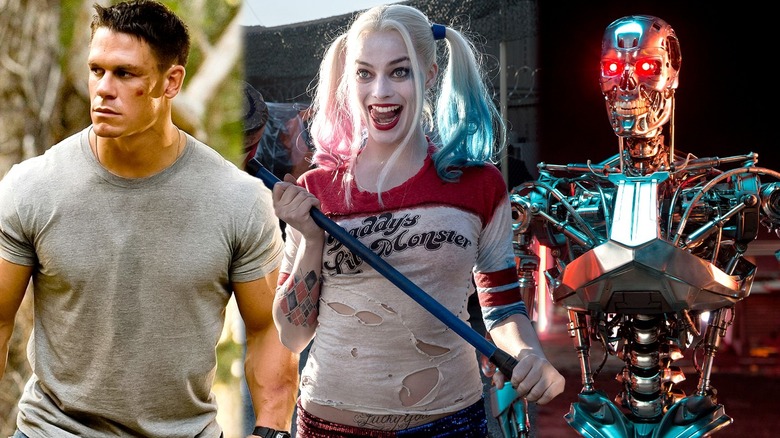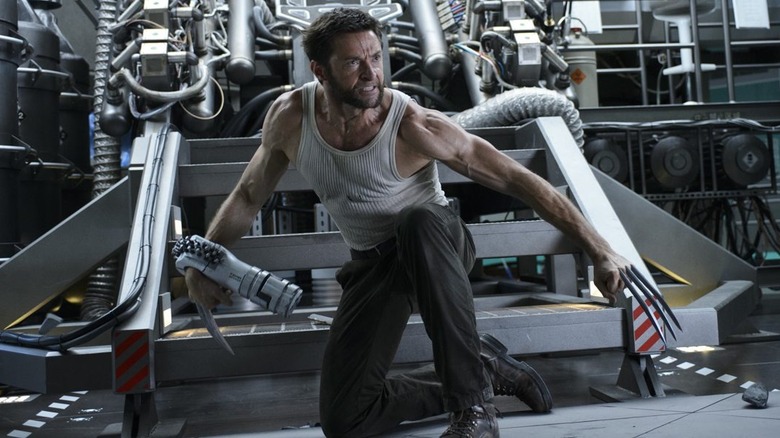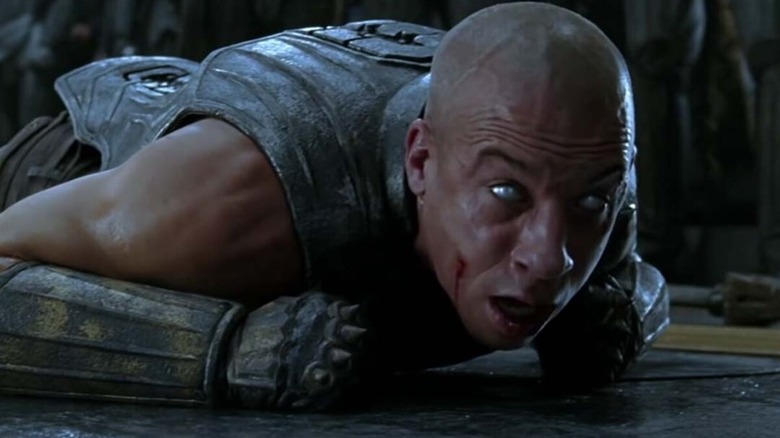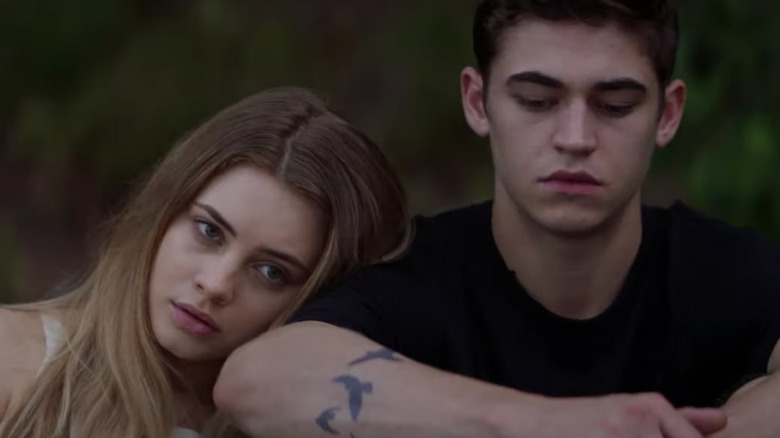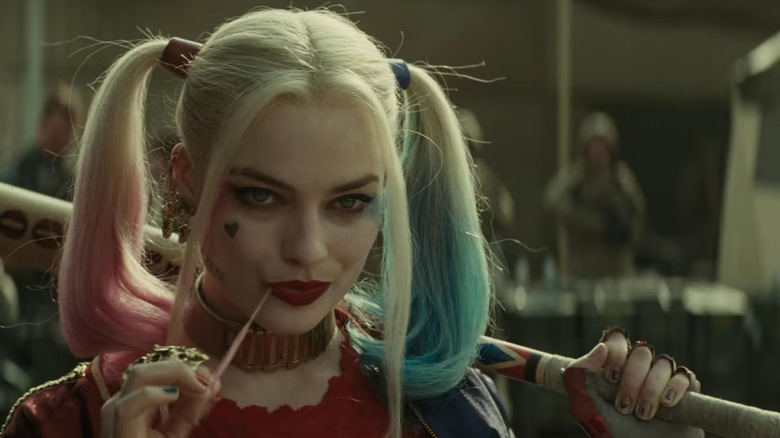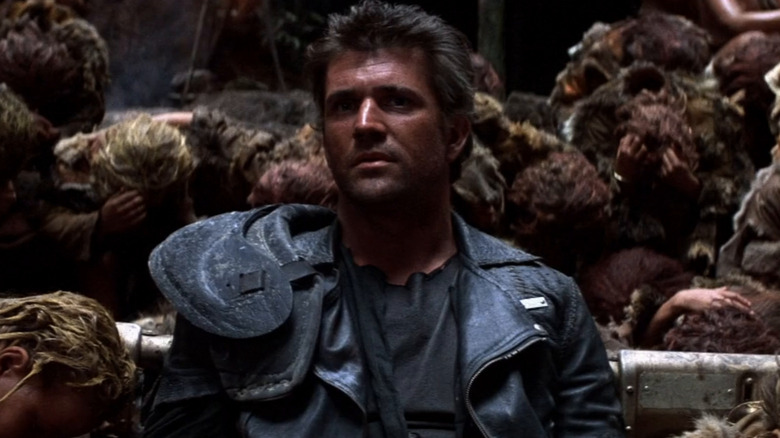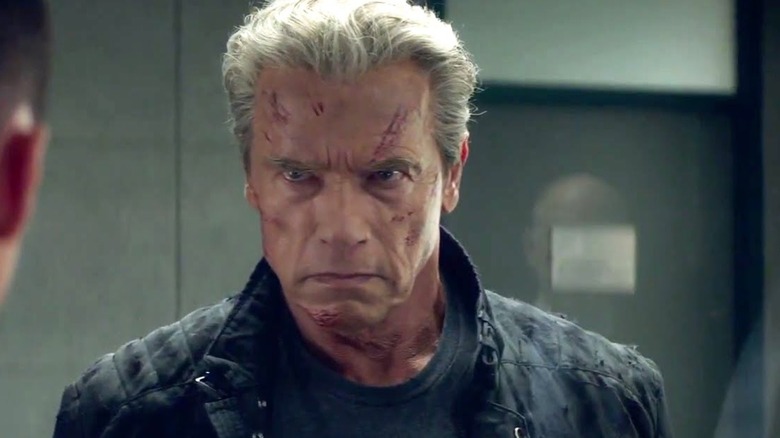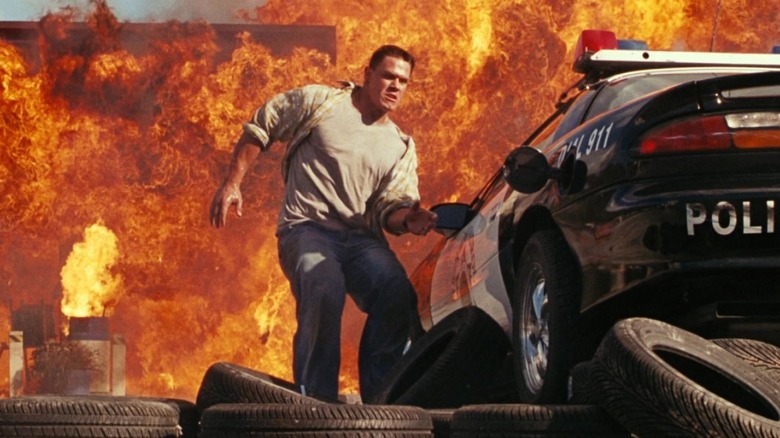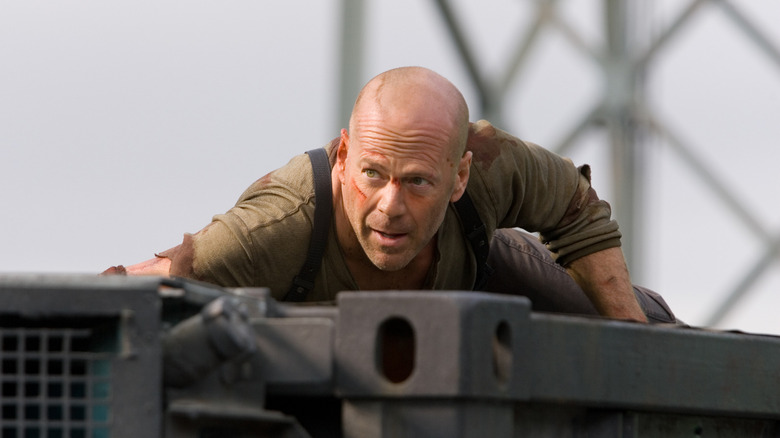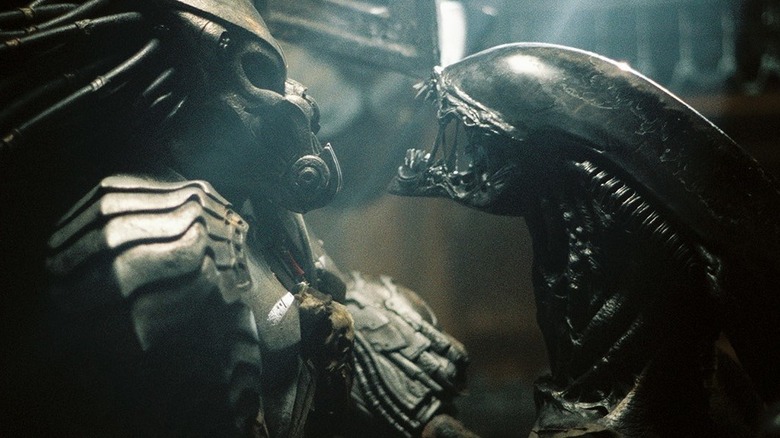Why These PG-13 Movies Got R-Rated Sequels
The vast majority of film franchises maintain a consistent rating throughout their existence. At most, the content might vary enough from one installment to the next to have some rated PG while others are rated PG-13, but it's rare that a sequel crosses over from a PG all the way to an R. When it does happen, the most common direction is for an R-rated movie to have PG sequels in an effort to increase the box office reach of the franchise — or, in the case of comedies that started in the 1980s, to have sequels cut out the gratuitous nudity that was often slipped into otherwise fairly tame movies, in the poorly-aged trend of that decade.
Perhaps the most unusual path for a movie series to take is for things to already be at a PG level and then go up to an R for a sequel. Despite some notable outliers, the overall trend is that R-rated movies don't do as well at the box office as PG movies for the simple fact that there are certain demographics that either can't or simply don't want to see an R-rated movie. So for a PG movie to have an R-rated sequel, there's usually a fascinating story behind why that decision was made. Sometimes it's for creative reasons, sometimes financial ones — and more often than not, it's a little bit of both.
The Wolverine
Though some of the smaller imprints are willing to push the envelope much further, most Marvel and DC comics keep things within what can best be described as PG territory in terms of content. There's occasionally blood, some bad words, and some brief glimpses of flesh from time to time, but you'll very rarely see F-bombs, dismemberment, or actual nudity in most mainstream comic book lines. As such, most movie adaptation of comic books have been PG-13 at their edgiest — and for much of their existence, the ones that did the best at the box office carried that rating.
"Deadpool" changed the game in 2016, becoming the highest-grossing R-rated movie ever made at the time of its release. This told studios that audiences would show up in huge numbers for R-rated comic book movies, and it definitely emboldened 20th Century Fox in particular to let its Wolverine trilogy go out in a blaze of gory glory the following year by having the PG-13 "The Wolverine" make way for the hard-R "Logan." Star Hugh Jackman was so committed to the movie being rated R that he was willing to take a pay cut to compensate for the lower budget that R-rated movies typically get by default.
"Logan" not only went on to also become one of the highest-grossing R-rated movies of all time, but it was the first superhero movie to ever be nominated for a screenwriting Oscar.
The Chronicles of Riddick
The "Riddick" franchise has been an interesting one indeed. It was kicked off by the surprise action/horror hit "Pitch Black" in 2000, one of the movies that helped put Vin Diesel on the map even before his debut as Dominic Toretto the following year in a certain multi-billion-dollar-grossing car movie franchise. When Diesel and director David Twohy wanted to expand the "Riddick" universe via the more ambitious and lore-heavy "The Chronicles of Riddick," what started out as an R-rated franchise had to become a PG-13 one in order for Diesel and Twohy to convince Universal to give them the nine-figure budget they needed for their 2004 sequel.
Though "Chronicles" was a box office flop, Diesel and Twohy remained passionate about the "Riddick" character and universe and teased a third film for years. Not satisfied with the creative sacrifices that had to be made in order for "Chronicles" to be PG-13, Diesel said he was determined to have the third installment — simply titled "Riddick" — be R-rated like the original movie and not have any of the restraints that a PG rating would put on the project.
It took nine years and Diesel having to leverage his house to get it funded, but "Riddick" was finally released in 2013 with its intended R-rating intact.
After
Anyone who has read the "After" series of books probably isn't the least bit surprised that three of its film adaptations are R-rated. They tell the story of young lovers Tessa (Josephine Langford) and Hardin (Hero Fiennes Tiffin) as they enter a relationship that is full of intense intimacy. The books, written by Anna Todd, began as fan fiction about a college girl's torrid affair with pop star Harry Styles that later reworked the male lead into a fictional guy and was turned into a popular series of erotic romance novels. The writing doesn't shy away from describing the ways that the two protagonists physically explore their feelings for each other.
However, what did likely surprise existing "After" book fans was that the first movie, 2019's "After," was only rated PG-13. It's not clear why a series that had already established itself for its fairly explicit descriptions of adults in sexual situations would tone things down to PG-13 for the movie version, when both the characters and the actors portraying them were already over 18 at the time. Perhaps it was just a way to test the waters on a new franchise and give it its best shot at finding the biggest audience possible.
Either way, first sequel "After We Collided" moved into R territory, and that's where the film series stayed for its subsequent two installments so far.
Suicide Squad
Though there had been some earlier R-rated comic book movie adaptations like "Blade" and "The Crow," the genre moved pretty firmly into PG and PG-13 territory — at least in terms of mainstream Marvel and DC properties — once things really started to take off with "Spider-Man," "Batman Begins," and the Marvel Cinematic Universe. Even the DC Extended Universe, which attempted to set itself apart from the MCU by being the home of darker, grittier comic book movies, stayed in PG-13 land for the first few years of its existence.
Margot Robbie spent several years trying to get an R-rated Harley Quinn spin-off movie made, following her debut as the character in the 2016 movie "Suicide Squad." It certainly can't be a coincidence that "Birds of Prey" and its R rating came a year after the massively successful 2019 R-rated "Joker" standalone film starring Joaquin Phoenix and directed by Todd Philips — not to mention the well-received and very adult "Harley Quinn" HBO animated series that also debuted in 2019.
Even though "Birds of Prey" didn't quite break even at the box office, critical reception was largely positive and certainly helped to pave the way for the half-sequel, half-reboot "The Suicide Squad," released in 2021, also being rated R.
Never Back Down
Even action movies aren't exempt from the tendency to try and stay PG in order to maximize their box office potential. It's unlikely that the target audience for a mixed martial arts movie about a gritty underground fight club is going to contain too many people that can't get into an R-rated film, but nevertheless, "Never Back Down" was released with a PG-13 rating in 2008. It didn't set the box office on fire, but it made a profit against its modest budget and did well enough for at least a direct-to-video sequel.
Once a theatrical run is taken out of the equation, ratings become much less important and it's very common for a series to get a lot edgier content-wise once that shift is made. As such, "Never Back Down 2: The Beatdown" — the directorial debut of prolific martial arts actor Michael Jai White — went R-rated and never looked back. The repetitively-titled third installment, "Never Back Down: No Surrender" — again directed by White, who also co-wrote the story — was also rated R, as was fourth entry "Revolt."
Mad Max Beyond Thunderdome
Few movie franchises have had as triumphant a return after both a long hiatus and a poorly-received entry as "Mad Max" did with the nearly flawless "Mad Max: Fury Road." It was a rare example of a movie being more or less wall-to-wall action and still managing to be critically acclaimed and even nominated for a Best Picture Oscar. Those accomplishments are impressive enough on their own, but even more so considering that the movie followed up the extremely disappointing "Mad Max Beyond Thunderdome," inarguably the franchise's low point.
After the surprising success of "Mad Max" and its sequel, "The Road Warrior," both of which earned an impressive amount of money against budgets that were both under $10 million, a third installment was a foregone conclusion. Surprisingly, "Beyond Thunderdome" being tagged PG-13 after two R-rated predecessors wasn't done so more money would be spent on the film, which still cost about $10 million. Toning down the violence and brutality didn't seem specifically done to reach a bigger audience in this case.
In actuality, director George Miller was grieving the loss of producing partner Byron Kennedy, who died while scouting locations for "Beyond Thunderdome." Miller decided to push on with the movie, if only that his friend's death was not in vain, and that's likely why "Beyond Thunderdome" ended up with its softer tone. When Miller finally returned to the franchise decades later, he was ready to make a proper, R-rated "Mad Max" movie again.
Terminator Genisys
"Terminator 2: Judgment Day" remains one of the greatest action films of all time, and it has held up remarkably well for a movie that is now more than 30 years old. That's why it's so disappointing just how badly the franchise lost its way after its underrated third installment, "Terminator 3: Rise of the Machines." Soft reboot "Terminator Salvation" failed to live up to its predecessors and came with a notable lack of Arnold Schwarzenegger. Even though Arnie returned for "Terminator Genisys," that movie saw the franchise get even further away from the greatness that it was once known for.
One problem was that both "Salvation" and "Genisys" went the PG-13 route in an effort to appeal to a wider audience — an odd move considering that "T2" and "T3" both did just fine with R ratings attached. When James Cameron rejoined the franchise for the first time since "T2" to co-write the story for "Terminator: Dark Fate,"while also bringing back Linda Hamilton for the first time since that same movie, the R rating was back as well. "Dark Fate" director Tim Miller didn't mince words when he told a Comic-Con crowd, "The DNA of 'Terminator' is an R-rated f***ing movie, so to not do it R seems disingenuous to the source material."
Unfortunately, despite the overwhelming consensus that "Dark Fate" finally got the ailing franchise back on track creatively, audiences had been too badly burned by previous installments and didn't show up for it.
The Marine
It can debated all day long which WWE wrestler-turned-actor has done the best job at making that transition. In terms of box office receipts, Dwayne Johnson is going to prove tough to beat. At the same time, Dave Bautista seems to be getting a lot of people on his side as the one with the strongest acting chops, with outlets like The A.V. Club and filmmakers like Rian Johnson among those making that proclamation. But it wouldn't be fair to count out John Cena just yet, as he's been slowly carving out his own successful acting path and deserves to also be part of that conversation.
Cena's first starring role in a movie was in 2006's "The Marine," which didn't get any critics on his side but did well enough at the box office to launch a prolific filmography of both movie and TV roles. In fact, Cena was already too big of a star by the time the first "Marine" sequel was underway to reprise his role, with the lead instead going to fellow WWE wrestler Ted DiBiase Jr. The direct-to-video movie also went from PG-13 to R as it upped the ante with more violence, more foul language, and more female skin (though no outright nudity).
This approach apparently worked for "The Marine 2," as four further installments of the series — from "The Marine 3: Homefront" to final entry "The Marine 6: Close Quarters" — retained the R rating.
Live Free or Die Hard
The original "Die Hard" might not be the hardest R action movie ever made, but it definitely would have lost something had it stayed within the confines of a PG-13 rating — after all, John McClane's (Bruce Willis) catchphrase literally contains an F bomb. After its huge success both in theaters and on home video, there was no reason to tone things down for "Die Hard 2." And after the success of that movie, it was a given that third installment "Die Hard with a Vengeance" would stay R-rated as well.
Yet when the "Die Hard" series returned from a 12-year absence with 2007's "Live Free or Die Hard," 20th Century Fox seemed less confident in the prospects of another R-rated romp and decided to take things down to PG-13 for the first time in the history of the franchise. While the result was a movie that did well with critics and was the best-performing entry in the franchise up to that point, its $382 million take in 2007 was technically a step down compared to the $366 million take for "With A Vengeance" in 1995 money — which is close to $600 million when adjusted for inflation.
Still, there was no reason to keep McClane's violent tendencies nor his potty mouth in check for the next entry, "A Good Day to Die Hard," which would be the last "Die Hard" movie Willis made prior to his retirement from acting in 2022. A planned prequel, featuring a younger version of John McClane, was eventually canceled.
Alien vs. Predator
Every "Alien" movie was rated R. Every "Predator" movie was rated R. So when it came time for the big crossover movie to happen, surely "Alien vs. Predator" was rated R too, right? Nope. Not having enough faith that the two franchises could bring their longtime fans — most of whom were well into adulthood by the time of the 2004 movie — into the theater, it was decided that the long-awaited cinematic showdown between two monsters from two R-rated franchises should take place within the confines of a PG-13 setting.
"Alien vs. Predator" was a disappointment by almost every measure, but was still too promising of an idea to let die after just one misstep. So a follow-up was released in 2007 that at least knew how to be a no-holds-barred, R-rated beatdown between the iconic enemies. Sure, "Alien vs. Predator: Requiem" was panned even harder than the previous film, did worse at the box office, and put plans on indefinite hold for future entries in that particular series. But at least it was R-rated like it deserved to be, so that's something.
As for the individual franchises, "Predator" recently came back strong with the critically-acclaimed 2022 Hulu prequel "Prey," while original "Alien" director Ridley Scott finally returned to that series in the 2010s with two fairly well-received entries in "Prometheus" and "Alien: Covenant." It would seem that the two franchises are better off alone, R-rated or otherwise.
